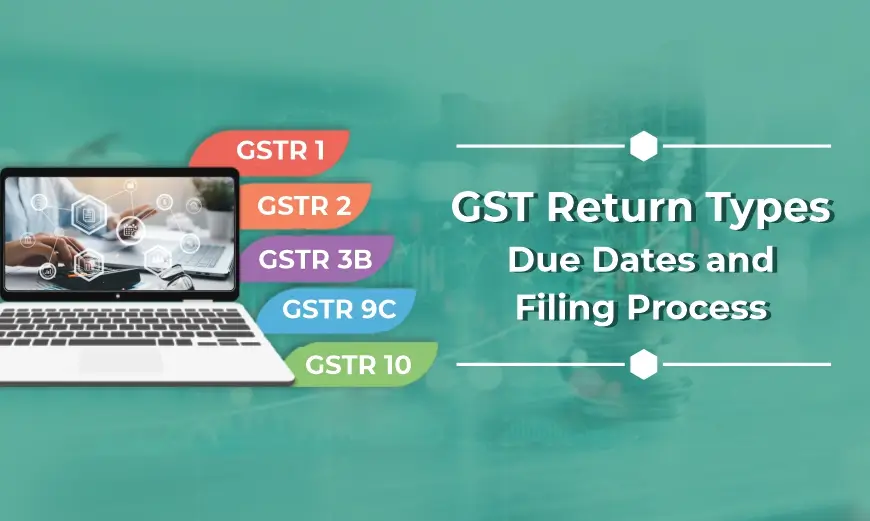
GST Return Types: Due Dates and Filing Procedures
The introduction of the Goods and Services Tax (GST) in India was a major milestone in the country’s taxation history. It replaced several indirect taxes with a single unified tax. It simplified the tax structure and made it more transparent and efficient. This reform has had a significant impact on businesses and individuals alike.
One important aspect of GST compliance is filing GST returns. GST returns are forms that taxpayers must file with the government to declare their GST liability. There are several GST return types, each with its purpose.
In this comprehensive guide, we will discuss the various types of GST returns in India, their significance, and the procedures involved. Read the complete guide and get the latest update on the GST return types and due dates.
Table of Contents
- What is GST Return?
- The Importance of GST Returns
- What are the types of GST returns and due dates?
- GSTR-1: Outward Supplies Return
- GSTR-2: Inward supplies Return
- GSTR-3B: Summary Return
- GSTR-4: Quarterly Return for Composition Dealers
- GSTR-5: Return for Non-Resident Foreign Taxpayers
- GSTR-6: Return for Input Service Distributors
- GSTR-7: Return for Tax Deducted at Source(TDS)
- GSTR-8: Return for E-commerce Operators
- GSTR-9: Annual Return
- GSTR-9A: Annual Return for Composition Dealers
- GSTR-9C: Reconciliation Statement
- GSTR-10: Final Return
- GSTR-11: Inward Supplies Return for UIN Holders
- The GST Return Filing Process
- Penalties for Late Filing
What is GST Return?
GST returns are documents that taxpayers registered under the GST law must submit to the tax authorities. These returns contain detailed information about a taxpayer’s business transactions, that helps in determining the amount of GST liability or refund. GST returns essentially serve as a link between taxpayers and tax authorities, ensuring compliance and revenue collection.
A Comprehensive Guide to GST Basic Concepts for Students
Or else you can also learn about GST through the GST certification Course
It’s important to know why different GST return types are important for businesses. In the next section, we will discuss the same so that you can analyze it better.

The Importance of GST Returns
GST returns are important for several reasons, including:
- Compliance: GST returns are essential for taxpayers to comply with the GST law. By accurately and timely filing GST returns, taxpayers can avoid penalties and legal consequences.
- Input tax credit: Businesses can claim input tax credit (ITC) on the GST they have paid on their purchases. This can help to reduce their GST liability. GST returns are used to calculate the amount of ITC that can be claimed.
- Transparency: GST returns provide a clear record of all transactions, which can help to improve transparency in the tax system. This can make it more difficult for businesses to underreport their income or evade taxes.
- Revenue collection: GST returns are crucial for the government to collect revenue. By tracking taxable transactions through GST returns, the government can ensure that the correct amount of tax is collected.
Let’s discuss the next part which is the different types of GST returns in detail. Here we will see who fills which type of GST return with due dates and significance. All this information will increase your knowledge base and help to become a GST expert.
What are the types of GST returns and due dates?
GST returns in India can be classified into several types. Each is customized to the needs of different taxpayers and specific transactions. Let’s take a closer look at each of these GST return types:
GSTR-1: Outward Supplies Return
This is the outward supply return, which is filed by taxpayers who supply goods and services. It contains information on invoices issued, debit/credit notes, and amendments.
- Who files: Registered taxpayers who supply goods and services.
- Frequency: Monthly.
- Details: Contains information on outward supplies made by the taxpayer during the reporting period. It includes invoices issued, debit/credit notes, and amendments.
- Importance: GSTR-1 is a crucial return as it serves as the basis for auto-populating data into the recipient’s GSTR-2 and the taxpayer’s GSTR-3.
- Due Date of filing GSTR 1: The due date for filing GSTR-1 is usually the 11th of the following month. For quarterly filers, it’s the 13th of the month following the end of the quarter.
GSTR-2: Inward supplies Return
- Who files: It is filed by businesses that have received goods or services from other registered suppliers.
- Frequency: GSTR-2 is typically filed every month.
- Details: GSTR-2 is an auto-generated statement that contains details of all the inward supplies received by the taxpayer during the month. It contains information like details of goods and services received during the tax period and details of imports and inward supplies attracting reverse charges. It also consists of amendments to details of inward supplies from previous tax periods and Corrections to details reported in earlier GSTR-2 returns.
- Importance: The GSTR-2 is important as it allows businesses to claim Input Tax Credit (ITC) for the GST paid on their purchases. It reduces their overall tax liability and aids in the reconciliation of data between suppliers and recipients. It ensures tax accuracy and compliance.
- Due Date of Filing GSTR 2: The due date for filing GSTR-2 is typically on the 15th day of the following month.
GSTR-3B: Summary Return
This is the summary return, which all regular taxpayers file. It contains summarized details of outward and inward supplies, input tax credits, and tax liability.
- Who files: All regular taxpayers.
- Frequency: Every month.
- Details: Summarizes outward and inward supplies, input tax credit, and tax liability for a given tax period.
- Importance: It provides a quick overview of a taxpayer’s tax liabilities and input tax credit claims.
- Due Date of filing GSTR 3B: The due date for filing GSTR-3B is the 20th of the following month.
GSTR-3B is an important compliance requirement for all regular taxpayers. Failure to file GSTR-3B on time and incorrectly can result in penalties and interest charges.
GSTR-4: Quarterly Return for Composition Dealers
This is the quarterly return for composition dealers, who are small taxpayers who pay GST at a fixed rate. It contains information on sales, purchases, and tax payments.
- Who files: Composition dealers
- Frequency: Quarterly
- Details: Contains a summary of sales, purchases, and tax payments for a composition dealer
- Importance: Enables composition dealers to declare their tax liabilities in a simplified manner.
- Due Date of filing GSTR 4 The due date for GSTR-4 is the 18th of the month following the quarter.
GSTR-5: Return for Non-Resident Foreign Taxpayers
This is the return for non-resident foreign taxpayers, who are taxpayers but are not residents of India. It contains information on supplies made, imports, and taxes paid.
Non-resident foreign taxpayers (NRFTs) are those who are not residents of India but who supply goods and services in India. They are required to file a monthly return called GSTR-5 to ensure that they comply with Indian GST regulations.
- Who files: NRFTs
- Frequency: Monthly
- Details: Contains details on supplies made, imports, and taxes paid by NRFTs
- Importance: Ensures that NRFTs comply with Indian GST regulations
- Due Date of filing GSTR 5: It is filed monthly, and the due date is the 20th of the following month.
GSTR-6: Return for Input Service Distributors
This is the return for input service distributors, who are businesses that distribute input tax credits to their customers. It contains information on the distribution of input tax credits.
- Who files: Input Service Distributors (ISDs) filed by those who distribute input tax credits.
- Frequency: Monthly.
- Details: Contains information about the distribution of input tax credit by the ISD.
- Importance: Ensures proper distribution of input tax credit among various branches or units of a business.
- Due Date of filing GSTR 6: The due date for GSTR-6 is the 13th of the following month.
GSTR-7: Return for Tax Deducted at Source (TDS)
Tax deducted at source (TDS) is a system where the government collects tax at the source of income. In the context of GST, TDS is deducted by businesses from their suppliers. GSTR-7 is the return that tax deductors file to declare the TDS that they have deducted.
- Who files: Tax deductors who deduct TDS under GST.
- Frequency: Monthly.
- Details: Contains details of TDS deducted, payable, and paid.
- Importance: Ensures accurate reporting and depositing of TDS to the government.
- Due Date of filing GSTR 7: The due date is the 10th of the following month.
GSTR-8: Return for E-commerce Operators
This is the return for e-commerce operators, who are businesses that facilitate the sale of goods and services through online platforms. It contains information on the supplies made through the e-commerce platform and the tax collected on such supplies.
- Who files: E-commerce operators
- Frequency: Monthly
- Details: Contains information on supplies made through an e-commerce platform and the tax collected on such supplies.
- Importance: Ensures compliance with GST regulations by e-commerce operators and pro9. GSTR-9A: Annual Return for Composition Dealersper reporting of transactions.
- Due Date of filing GSTR 8:The due date is the 10th of the following month
GSTR-9: Annual Return
This is the annual return, which all regular taxpayers file. It contains a comprehensive summary of all GST returns filed during the financial year.
- Who files: Regular taxpayers
- Frequency: Annually
- Details: Contains a comprehensive summary of all GST returns filed during the financial year.
- Importance: Provides a consolidated view of a taxpayer’s annual GST transactions.
- Due Date of filing GSTR 9 The due date for filing GSTR-9 is typically December 31 of the following financial year.
GSTR-9A: Annual Return for Composition Dealers
This is the annual return for composition dealers, which composition dealers file. It contains a summary of supplies, tax liability, and payments made during the financial year. It can be helpful for composition dealers to track their GST compliance and to identify any areas where they may be overpaying or underpaying taxes.
- Who files: Composition dealers
- Frequency: Annually
- Details: Contains a summary of supplies, tax liability, and payments made by composition dealers during the financial year.
- Importance: Ensures compliance by composition dealers and provides an overview of their annual transactions.
- Due Date of Filing GSTR 9A: The due date for filing GSTR-9 is December 31 of the following financial year.
GSTR-9C: Reconciliation Statement
Taxpayers with an annual turnover exceeding a specified threshold are required to file an annual return called GSTR-9C. This return contains a reconciliation statement and certification by a Chartered Accountant. The reconciliation statement compares the taxpayer’s financial records to the GST returns filed during the year. The CA certification assures that the reconciliation statement is accurate and complete.
- Who Files: Taxpayers with an annual turnover exceeding a specified threshold.
- Frequency: Annually.
- Details: Contains a reconciliation statement and certification by a Chartered Accountant.
- Importance: Ensures reconciliation between the taxpayer’s financial records and GST returns filed during the year.
- Due Date of Filing GSTR 9C: The due date for filing GSTR-9C is typically December 31 of the following financial year.
GSTR-10: Final Return
GSTR-10 is a final return that is filed by taxpayers who have opted for GST cancellation. It contains final details of the taxpayer’s supplies, tax liability, and assets and liabilities at the time of cancellation.
- Who files: Taxpayers who have opted for GST cancellation.
- Frequency: Once, at the time of cancellation.
- Details: Contains final details of supplies, tax liability, and assets and liabilities at the time of cancellation.
- Importance: Ensures proper closure of a taxpayer’s GST account.
- Due Date of Filing GSTR 10:It is filed within three months of the date of cancellation or order of cancellation, whichever is later.
GSTR-11: Inward Supplies Return for UIN Holders
Unique Identification Number (UIN) holders are entities that are not registered under GST but receive inward supplies from registered suppliers. They must file a monthly return called GSTR-11 to declare the inward supplies they have received.
- Who files: Unique Identification Number (UIN) holders (e.g., foreign embassies).
- Frequency: Monthly.
- Details: Contains information on inward supplies received by UIN holders.
- Importance: Ensures compliance by UIN holders and helps them claim refunds.
- Due Date of Filing GSTR 11: The due date is the 28th of the month following the month for which it is being filed.
If you are stuck at any point in understanding GST return types in the article or are interested in learning GST. Then explore these courses for more knowledge enhancement.
The GST Return Filing Process
The GST return filing process in India involves the following steps:
- Maintaining records: Taxpayers must maintain accurate records of all transactions, including invoices, debit/credit notes, and receipts. It is important to ensure that the data that is entered into the GST portal is accurate.
- Data entry: Taxpayers enter transaction details into the GST portal or use accounting software that can connect to the portal. This can be done manually or using an automated system.
- Validation: The GST portal validates the data that is entered, checking for errors and discrepancies. It helps to ensure that the data is accurate and that it meets the requirements of the GST law.
- Payment of tax: Taxpayers pay the GST liability through online banking or other approved methods. This can be done on a monthly or quarterly basis, depending on the taxpayer’s category.
- Filing returns: Taxpayers file the appropriate GST return on the GST portal. The return may include GSTR-1, GSTR-3B, GSTR-4, etc., depending on the taxpayer’s category and frequency.
- Reconciliation: Taxpayers reconcile their books of accounts with the filed returns to ensure accuracy. It helps to identify any errors or discrepancies that may have occurred during the filing process.
- Correction: If errors are identified, taxpayers can correct them in subsequent returns. This can be done by filing an amended return.
- Refund claims: If eligible, taxpayers can claim refunds for excess tax payments. This can be done by filing a refund claim with the GST authorities.
If you have read the article carefully, hope your concept of types of GST returns and due dates is clear to some extent. Otherwise, you can also check this related article on GST for basic concepts.
Penalties for Late Filing
If a taxpayer fails to file their GST return on time, they may be liable to pay a late fee. The late fee is calculated as a fixed amount per day of delay for both CGST (Central Goods and Services Tax) and SGST (State Goods and Services Tax) or UTGST (Union Territory Goods and Services Tax).
The late fee for most taxpayers is Rs. 100 per day of delay per return (Rs. 50 for CGST and Rs. 50 for SGST/UTGST). It means that if a taxpayer fails to file their return by one day, they will be liable to pay a late fee of Rs. 100. If they fail to file their return by two days, they will be liable to pay a late fee of Rs. 200, and so on.
The maximum late fee that can be charged is Rs. 5,000 per return. It means that even if a taxpayer delays filing their return by a significant amount of time, they will only be liable to pay a maximum of Rs. 5,000 in late fees.
It is important to note that the late fee is not the only penalty that can be imposed for late filing of GST returns. The GST authorities may also impose an interest charge on the outstanding amount of GST. The interest rate is currently 18% per annum.
To avoid late fees and interest charges, it is important to file GST returns on time. The GST portal has a reminder system that can help taxpayers stay on track with their filing deadlines.
Learn and earn. Master your skills with different GST certification courses and explore the upcoming opportunities as a GST expert.
Manage Multiple GST in TallyPrime Release 3.0 – A Step-by-Step Guide
GST Reconciliation in TallyPrime: A Comprehensive Guide with Real-Life Examples
Ultimate GST Audit Checklist (FY 2022-23) for Ensuring Compliance and Avoiding Penalties
Key Takeaways
GST return filing is an essential part of the GST regime in India. Businesses and individuals must understand the different types of GST returns applicable to them and adhere to the prescribed filing deadlines.
Staying informed about any changes or updates to GST regulations is essential for taxpayers in India. By understanding the various GST return types and the procedures involved, taxpayers can contribute to a more transparent and efficient taxation system.
Top 15 Common GST Interview Questions and Answers
SAP FiCO Interview Questions – Prepare for Your Next Interview
- Why the ICA Franchise is Your Best Business Move in Revolutionizing Education - January 13, 2026
- 50 Important Rectification Of Errors Questions For Interview - January 5, 2026
- 50 Important Cash Book Questions & Answers For Interview Preparation - January 5, 2026

.jpg)























[…] Meanwhile, if you are searching for GST guides then check out this article A Comprehensive Guide to GST Basic Concepts for Students Types of GST in India: IGST, SGST, CGST & UTGST Made Easy for Students GST Return Types: Due Dates and Filing Procedures […]